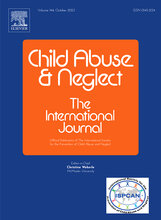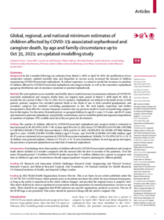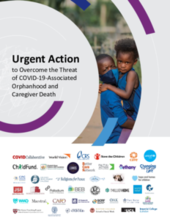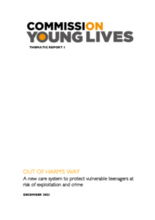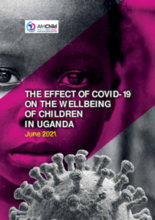This section highlights tools and resources for child protection in the COVID-19 pandemic.
Displaying 1 - 10 of 264
This study based in Canada explored views on the changes in child safety reporting and interventions with newcomer families during the COVID-19 pandemic.
Limited research has investigated the impact of COVID-19 on Out-of-Home Care (OOHC) and child protective services (CPS) worldwide or explored how CPS overcame the challenges of helping children in OOHC. This review aims to address this gap in the research to unveil the ‘positive legacy’ left by CPS in their work with children in OOHC during COVID-19.
At least 5 million children have lost a parent or caregiver due to #COVID19 since March 2020, updated figures suggest. The authors urge actions to prioritise affected children, incl. economic strengthening, enhanced community and family support, and education.
An estimated 6.7 million children have suffered from COVID-19-associated orphanhood and caregiver death in the past two years (as of January 15, 2022). This number is rapidly growing: every 6 seconds another child loses a parent or caregiver. This report, issued by dozens of leading international NGOs, outlines the magnitude of loss globally due to COVID-19 and presents tangible steps that the U.S. government can take to support children and families.
This report highlights the changing characteristics of children in and on the ‘edge of care’, including unaccompanied minors, increasing numbers of young people with unmet complex needs and BAME young people.
This study is part of a larger initiative using an international platform to examine child maltreatment (CM) reports and child protective service (CPS) responses in various countries. The first data collection, which included a comparison between eight countries after the pandemic's first wave (March–June 2020), illustrated a worrisome picture regarding children's wellbeing. The current study presents the second wave of data across 12 regions via population data (Australia [New South Wales], Brazil, United States [California, Pennsylvania], Colombia, England, Germany, Israel, Japan, Canada [Ontario, Quebec], South Africa).
This study examined patterns of sexual violence against adults and children in Kenya during the COVID-19 pandemic to inform sexual violence prevention, protection, and response efforts.
In this How We Care series, Family for Every Child has presented the programming of 3 of its CSO members who have been working on the ground on preventing domestic violence affecting children during COVID-19.
The assessment of COVID-19 effect on the Wellbeing of Children in Uganda was conducted between June and August, 2020 by AfriChild Centre, Makerere University. The study took a retrospective approach with a focus on the three months of the COVID-19 lock down (AprilJune 2020) to counter contradictions that could arise from a longer study period in the face of changing dynamics of COVID-19.
The current discussion paper explored the impact of COVID-19 on child maltreatment reports and CPS responses by comparing countries using available population data.


